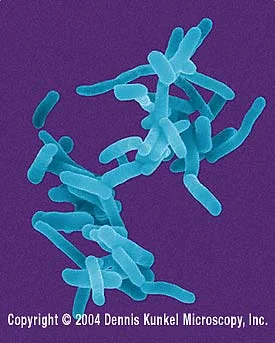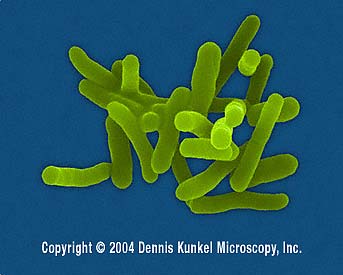SHIGELLA FACT SHEET
What is Shigellosis?
Shigellosis is an acute intestinal illness caused by a group of bacteria called Shigella. For general information on bacteria, see the Bacteria fact sheet. There are four species of Shigellae; Shigella sonnei (abbreviated S. sonnei or “Type D”), S. flexneri (or “Type B”), S. boydii and S. dysenteriae.
In developed countries, S. sonnei and S. flexneri account for nearly all cases of shigellosis (S. sonnei is responsible for approximately two thirds of all cases in the United States). In developing countries, S. flexneri and S. dysenteriae are common, and S. boydii exists only on the Indian subcontinent. Within the species are several serotypes of Shigella; serotypes are groups of bacteria that are similar to each other, but can still be told apart by certain characteristics. In fact, there are 40 different serotypes within the four Shigella species! One type of S. dysenteriae, called S. dysenteriae type 1, is responsible for many of the severe or fatal cases of shigellosis. Throughout the world, S. flexneri is the most common species of Shigella.
Electron Microscope Pictures of Shigellae
Electron Microscope Pictures of Shigellae
What Are the Symptoms and the Incubation Time?
The most common symptom of shigellosis is diarrhea, which often contains blood and mucus from the intestinal walls. Other symptoms may include fever, nausea, vomiting, loss of appetite, dehydration and stomach cramps. For young children, a fever and infection may lead to convulsions. Some people may remain asymptomatic (not develop symptoms) while infected. Symptoms usually appear 12 to 96 hours after infection.
How Long do the Symptoms Last?
People with healthy immune systems are usually ill for five to seven days before the symptoms disappear, though the infection may remain in the body for one to two weeks afterwards. About three percent of people who are infected with S. flexneri will develop Reiter’s Syndrome, which is characterized by joint pain, eye irritation and painful urination. Reiter’s Syndrome can last several months or years, and can lead to chronic arthritis, but is a rare complication.
How is it Diagnosed?
Shigellosis cannot be diagnosed by its symptoms alone, because diarrhea is a common symptom of many intestinal diseases. If shigellosis is the suspected cause of intestinal illness, a request should be made to have a fecal sample tested for the Shigella bacteria.
Am I at Risk for Disease?
Shigella is most likely to infect toddlers (aged two to four), and is most severe in young children, the elderly and those with impaired immune systems. S. flexneri, S. boydii and S. dysenteriae are prevalent in developing countries and S. sonnei is the most common type of Shigella in developed countries. S. dysenteriae type 1 is the most severe variety of shigellosis and has a fatality rate of 5 to 15 percent. However, because S. dysenteriae type 1 is not found in developed countries, shigellosis tends to be more severe and fatal in developing countries.
How are Shigellae Spread?
Shigellae may be found in soil, food and water, or on surfaces that have been contaminated with the feces of infected people. Shigellae are not spread by blood, but can be spread by ingesting food or water that has come into contact with the feces of an infected person. Vegetable crops may become contaminated if contaminated manure is used on the field in which they are grown. Flies can carry enough of the Shigella bacteria to contaminate food. Swimming pools, hot tubs, water parks, lakes, rivers, and oceans can become contaminated from the Shigella bacteria if the water comes into contact with infected feces.
How Can I Prevent Getting Shigellosis?
The best ways to prevent getting sick with shigellosis are to practice good hygiene and avoid food and water that may be contaminated. When swimming, you should avoid swallowing the water. When traveling, you should boil your water, cook your own food and peel your own fruits. Proper storage of refrigerated foods can prevent food contamination. There are also many prevention methods that focus on the water supply, such as ensuring that wastewater and sewage cannot contaminate a water supply.
How do I Prevent Spreading it to Others?
You can prevent spreading shigellosis to others by following the same guidelines that are given to prevent getting shigellosis. If you become infected with shigellosis, it is extremely important to wash your hands after you use the bathroom, and before preparing and eating food. If possible, you should avoid preparing food for others while you are sick. You should also avoid swimming while you have shigellosis, and wait several weeks after the symptoms disappear before you go swimming, because you may still have the bacteria in your body.
What is the Treatment for Shigellosis?
People with healthy immune systems usually recover on their own, and develop a short term immunity to the type of Shigella that they were infected with. As with any diarrheal illness, it is important to drink lots of fluids, to prevent dehydration. Some varieties of Shigella have become resistant to certain antibiotics, so antibiotics are often used only in severe cases. Antidiarrheal agents should not be used, as they will only make it worse. Vaccines are being developed for shigellosis, but the best method of control is the method of prevention.
How Prevalent are Shigellae in My Water Supply?
Shigellae may be more prevalent in surface waters, such as rivers, lakes and shallow wells, than in groundwater sources. Surface waters can be easily contaminated by sewage. Water treatment plants can remove Shigellae with the use of chlorine, so the bacteria are more prevalent in raw, untreated water. Shigellosis occurs more in the summer than in the winter. Communities that effectively treat sewage and keep water supplies safe drastically reduce the number of cases of shigellosis.
How Can I Protect My Water Supply?
The following guidelines will reduce the risk of contaminating your water supply with Shigellae:
Make sure fecal contamination of your water is minimized by collecting and storing water appropriately. If possible, store drinking water in an above ground tank. If you store water underground, make sure it is properly sealed.
Make sure that runoff and sewer pipe leaks cannot enter your water supply.
Make sure that your drinking water pipes are completely separate from all other plumbing, and that all pipes are properly sealed.
Regularly cleaning and maintaining your water tank and pipes, and sewage pipes will ensure that Shigellae, as well as other bacteria, are not able to contaminate your drinking water.
Ensure that your water supply is safe and properly disinfected. If you use a private water source, this will include regular testing of the water quality.
How Difficult is it to Remove Shigellae from Water?
Remember that even when water looks clean, it can contain many harmful bacteria, including Shigellae. Water treatment facilities use chlorine to inactivate any Shigellae that are in the water. However, if extra precaution is required or if you get water from a private water source, you can bring water to a rolling boil for one minute (or for a longer time at high altitudes) to inactivate any Shigellae that may be in it. If your water is turbid (meaning that there is a lot of suspended solid material in it, and it appears cloudy), you should filter it before chlorination.
The Safe Drinking Water Foundation has educational programs that can supplement the information found in this fact sheet. Operation Water Drop looks at the chemical contaminants that are found in water; it is designed for a science class. Operation Water Flow looks at how water is used, where it comes from and how much it costs; it has lessons that are designed for Social Studies, Math, Biology, Chemistry and Science classes. Operation Water Spirit presents a First Nations perspective of water and the surrounding issues; it is designed for Native Studies or Social Studies classes. Operation Water Health looks at common health issues surrounding drinking water in Canada and around the world and is designed for a Health, Science and Social Studies collaboration. Operation Water Pollution focuses on how water pollution occurs and how it is cleaned up and has been designed for a Science and Social Studies collaboration. To access more information on these and other educational activities, as well as additional fact sheets, visit the Safe Drinking Water Foundation website at www.safewater.org.
Did you know that our Operation Water Health program teaches students about what safe drinking water is, what unsafe drinking water is, and the health problems that can be caused by unsafe drinking water? Please help us to keep our Operation Water Health program up-to-date! Please chip in $5 or donate $20 or more and receive an Official Donation Receipt for Income Tax Purposes.
Resources:
Centers for Disease Control and Prevention. February 2016. Shigellosis.
https://www.cdc.gov/shigella/index.html
Public Health Agency of Canada: Notifiable Diseases On-Line. June 2016.
http://diseases.canada.ca/notifiable/
United States Pathogenic Microorganisms and Natural Toxins Handbook. January 2002. Shigella.
http://pdf.usaid.gov/pdf_docs/PNADO152.pdf



